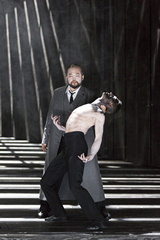| Opera Reviews | 25 April 2024 |
An ambiguous Dutchman that descends into chaosby Moore Parker |
|
| Wagner: Der Fliegende Holländer Theater an der Wien 19 November 2015 |
|
|
What begins as a powerfully dark and tightly-knit concept unravels - not least through its awkward physical exchanges between set altitudes, and superfluous props (such as a miniature house model which is passed around from scene to scene) into a calamity of chaos, which - while possibly reflecting the leading lady’s conscious state - ultimately slips towards an irritatingly vague information overload. Senta is here the focal character (indeed, the entire depiction is conceivably purely a window revealing the meanderings of her distressed mind). Satan becomes a vital tangible figure who augments the action in the form of a half-naked dancer (highly expressive, Pavel Strasil). In general, the characters - while vibrant in energy - remain somewhat isolated cardboard cut-outs. An imposing triangular construction extending downstage at its apex to form a claustrophobic and foreboding enclosure (design, Pierre-André Weitz) progressively disintegrates into sections depicting a bedroom, cemetery, sea vessel, and so on, in a rotating carousel of images and settings to accommodate the unfolding elements of the drama. Bertrand Killy is responsible for the production’s atmospheric lighting. The cast is well-balanced with Samuel Youn’s fine-toned Holländer providing an introspective contrast to Lars Woldt’s effectively bombastic Donald (Daland). As Senta, Ingela Brimberg maintained unflinching intensity while vocally mastering the score’s challenges with only the occasional hint of duress at the top of her range. Bernhard Richter’s exceptional Georg (Erik) displayed thrilling breadth of tone and dynamic range to accompany his credible stage work and an auspicious stage presence. Manuel Günther made his mark as a sweet-toned, dapper Steuermann, and Ann-Beth Solvang well complimented the cast with her richly-toned Mary. Disappointingly, the Arnold Schoenberg Chor was slightly out of their depth - at times lacking the vocal weight and range (tenor section) to comfortably serve the score. On period instruments Marc Minkowski’s Les Musiciens du Louvre produced a rare palette of colours and dynamics in a reading full of chamber-like detail (yet raising the roof when required) and indeed, one quite compelling in this rather atypical venue for the Wagnerian repertoire. Some booing infiltrated the bravi for the pit at the final curtain. Early in the production Senta scores the word “Erlösung” Ambiguity prevails!
|
|
| Text ©
Moore Parker Photo © Werner Kmetitsch |

 Robert Browning’s paradigm “Less is more” might have been a considered admonition for Olivier Py’s Theater an der Wien production of Wagner’s original 1841 one-act version of Der Fliegende Holländer.
Robert Browning’s paradigm “Less is more” might have been a considered admonition for Olivier Py’s Theater an der Wien production of Wagner’s original 1841 one-act version of Der Fliegende Holländer.





